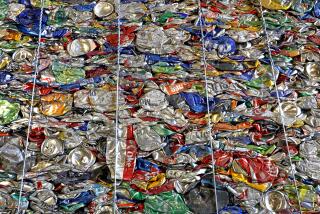‘E-waste’ recyclers at your disposal
It’s a sunny, breezy Friday morning in Huntington Beach, and the parking lot of the Central Park Sports Complex looks like a cross between a Best Buy blowout and the Museum of Consumer Electronics.
The jetsam of America’s love affair with electronic gadgetry is stacked on pallets as cars intermittently pull up to unload more televisions, computer monitors, cellphones and the odd electric fan.
Here’s a wood-paneled Akai reel-to-reel tape deck, redolent of the ‘70s. Over there, a carton of cellphones, some as big as a shoe. And over here, a 36-inch TV that would look fine in any den -- if only it were HD-ready.
To Randy Lewis, all of this is more than castoff technology. It’s the raw material that fuels his business, SoCal Computer Recyclers Inc. in Harbor City.
“Something like that we’re going to tear apart for aluminum, plastics, circuit boards,” he remarks while examining the Akai. “The wood’s treated, so we can’t do anything with it. It goes to the landfill.”
Lewis will collect 45,000 pounds of discarded electronics over the two-day event, held in conjunction with Huntington Beach’s Department of Public Works.
Partnering with cities that need help disposing of such materials is a standard tactic for Lewis and the more than 600 other recyclers and collectors of “e-waste” in California.
By now, he has developed an insider’s knowledge of what lurks in the garages and attics of Southern California.
Checking out an ancient dot-matrix printer, Lewis observes: “It’s not an event unless we get a copying machine, a coffee maker and a fan.”
Household junk notwithstanding, e-waste recycling is a growth business in California these days. The amount of e-waste, which includes the packaging, generated each year in the United States grew by 17% from 2000 to 2005, making it the fastest-growing source of solid waste on the planet, said John Shegerian, chief executive of Electronic Recyclers International Inc. in Fresno.
Among the drivers are the changeover to new, feature-laden cellphones -- Americans toss out 130 million mobile phones a year, the Environmental Protection Agency estimates -- and the rapid replacement of TVs and computer monitors that use cathode ray tubes, or CRTs, with flat-panel devices.
The release last month of Vista, Microsoft Corp.’s first new computer operating system in five years, could add to the pile by prompting home computer users and businesses to invest in new PCs -- relegating older models to the waste stream.
Only about 10% of e-waste is recycled, according to U.S. government figures. Californians alone dumped 450,000 tons of the stuff last year.
Most consumer electronics contain toxic materials such as lead, copper and cadmium and cannot legally be dumped in municipal landfills. At the same time, makers of computers and other devices are hungry to buy the recycled plastic, metal and glass that can be gleaned from the discarded devices.
“There’s an insatiable appetite for these materials,” said Shegerian, who says his company is the biggest e-waste recycler in the state, with $20 million in 2006 revenue.
But what really sparked the e-waste boom in California was a state law that dramatically improved the profit potential of electronics recycling.
Since Jan. 1, 2005, buyers have paid a fee of $6 to $10 on every TV, laptop, computer monitor and other CRT device purchased in California. The state pays the money to companies that collect and recycle CRTs, each of which contains 4 to 8 pounds of lead. The going rate is 48 cents a pound, split by the company that collects the waste and the company that recycles it. (Companies that do both keep the entire payment.)
A 19-inch CRT computer monitor weighs 40 to 50 pounds, so the money can add up fast. The state paid out $74.6 million in 2005-06.
And that, in turn, has shifted e-waste recycling into expansion mode. At the end of 2004, there were 150 e-waste collectors and 12 recyclers in the state, the California Integrated Waste Management Board says. Now there are 544 collectors and 62 recyclers.
“There’s getting to be a lot of competition in this business,” said Lewis, whose revenue sagged last year in the suddenly crowded marketplace, falling to $750,000 from $1 million in 2005. “People say, ‘The government’s giving away money. Hey, I can do that.’ ”
Cities and counties also have set up free collection centers for household e-waste, but they typically operate on limited hours or only on certain days of the month.
To cover his costs, Lewis used to charge $10 to take in old monitors. Now, with the payments from the state as an incentive, he actively seeks out the devices at events such as the one in Huntington Beach.
SoCal Computer Recyclers, like other collection firms, also accepts household e-waste at its Harbor City facility. House calls are generally reserved for businesses or other high-volume customers.
Although Lewis operates primarily as an e-waste collector, he also is considered a recycler because his company breaks down some components into circuit boards, cables, plastics and so forth. Workers wear gloves and masks when handling potentially toxic materials, he said, and the chances of contamination are remote.
Lewis will take in just about any type of castoff electronics -- he has been known to pull over and pick up TVs left beside the road -- but he draws the line at household waste such as batteries. To ease concerns about identity theft, SoCal Computer Recyclers will erase the data from the hard drives of all PCs before they are disassembled or resold.
Lewis said he was still making a profit and hoped to see his revenue rebound this year. But it’s a bit off-putting for a guy who is a relative old-timer according to the e-waste industry’s abbreviated timeline.
“He’s one of the folks who was in this game before it was cool,” said Mark Murray, executive director of Californians Against Waste, a Sacramento-based lobbying group that promotes recycling.
Lewis’ tale of how he got into the business sounds a bit like a Hollywood screenplay. Back in the 1990s, he was working -- unhappily -- as a financial analyst at Silicon Valley giant Sun Microsystems Inc. One day at a Chinese restaurant in Sunnyvale, he cracked open a fortune cookie and read: “You control the gravity on this planet -- lighten up.”
“I was sitting in my car the next morning, reflecting on that,” Lewis recalled. “I said to myself, ‘Stop hating your job or leave your job.’”
He chose the latter course, decamping for Southern California, where he used a $25,000 loan from his father to launch SoCal Computer Recyclers in 1998.
In October of that year, he held his first municipal recycling fair, in Redondo Beach. Seventy-five people came by and dropped off 3,100 pounds of material, mostly computers and monitors. At a similar event in Torrance in April 1999, more than 600 people showed up.
“We were there until midnight cleaning up that parking lot,” Lewis said.
His company was profitable by the third year and is now ensconced in a 20,000-square-foot facility in Harbor City, where he has 15 employees, including four developmentally disabled workers from the nearby South Bay Vocational Center.
Last year, Lewis and his team collected 26,000 monitors. Of those, 18,500 were broken down and sent to Shegerian’s company in Fresno for recycling. The rest were resold or donated to schools, churches and the like.
At the Huntington Beach recycling event, Lewis mentally totes up his expenses during a midmorning lull. Fourteen blue-shirted workers to manhandle equipment (his 18-year-old daughter, Cheyenne, assigned to survey the customers, is working without pay), advertising, truck rental -- it all comes to about $750 an hour.
It’s not all business for the 38-year-old Lewis, who grew up in “Surf City.” There’s something about an electronics junkyard that evokes memories of things past.
“Look at this,” he calls out from one pile of moldering plastic and metal. “Here’s an IBM Selectric. When was the last time you saw one of those?”
A few minutes later, his attention is drawn to a Dimension 68000 computer that dates to the Paleozoic Era of the personal computer revolution (circa 1981 or 1982).
“I had a computer like that in the eighth grade!”
Giving away their technomementoes -- including ones with established value on the recycling market -- doesn’t appear to bother Lewis’ customers. They’re just happy to get rid of the stuff responsibly.
“I’ve had garage sales, and computers don’t sell,” said Sandy King of Huntington Beach. “It was also good to be able to bring it to a place where they clean your information off the computer.”
As King talked, Lewis’ crew unloaded a 10-year-old computer, a printer “and an old, old stereo, maybe 30 years old,” from her car.
“I didn’t bring in the turntable,” she said. “I decided to keep it. You never know -- albums may come back.”
*
*
Begin text of infobox
Sources of ‘e-waste’
*--* TVs 55.6% Electronics packaging 17.9% Commercial electronics 10.1% Other household electronics 6.1% Computer monitors 5.9% Personal computers 4.4%
*--*
Figures are for 2002, the latest available
*
Source: U.S. Environmental Protection Agency
Los Angeles Times
**
Basic e-waste questions answered
What is e-waste?
Discarded electronic devices such as televisions, computers, monitors, fax machines, VCRs and cellphones. These items typically contain toxic materials such as lead, cadmium and mercury and cannot be safely dumped in landfills.
What should I do with my e-waste?
More than 600 e-waste collectors and recyclers operate in California. In accordance with state law, most accept TVs, laptops and monitors. Many also accept desktop computers, cellphones, VCRs and other devices. In addition, many nonprofit organizations accept donations of computer equipment if it is in working order.
(In either case, when disposing of a computer, be sure to remove sensitive personal information from the hard drive. Some e-waste collectors will do this for you.)
Retailers such as Best Buy Co. will accept discarded cellphones, batteries and inkjet cartridges.
What are municipal governments doing?
Cities and counties operate free disposal sites for hazardous waste, although hours of operation often are limited. For dates, times and locations of collection points for household hazardous material (including e-waste) check these websites: Los Angeles County, ladpw.org/epd/hhw/index.cfm and www.lacsd.org/info/hhw_e_waste/default.asp; Orange County, www.oclandfills.com/hhwcc.asp; Ventura County, www.wasteless.org/5_5HHWCollect.html; Riverside County, www.rivcowm.org/hhw/hhw_schedule.html. Most city governments also operate programs.
Where can I get more information?
For an overview of the e-waste problem and a list of approved collection sites, go to www.erecycle.org.
Starting next month, the Consumer Electronics Assn. will provide a calendar of recycling events sponsored by retailers and local governments at www.mygreenelectronics.org.
-- Martin Zimmerman
More to Read
Inside the business of entertainment
The Wide Shot brings you news, analysis and insights on everything from streaming wars to production — and what it all means for the future.
You may occasionally receive promotional content from the Los Angeles Times.










